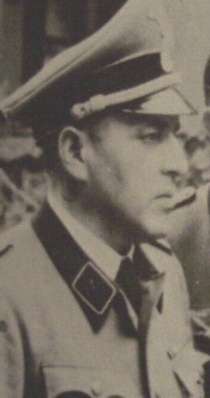Peter Högl
| Peter Högl | |
|---|---|
 | |
| Born |
19 August 1897 Dingolfing, Bavaria |
| Died |
2 May 1945 (aged 47) Berlin, Germany |
| Allegiance |
|
| Service/branch |
|
| Years of service | 1916-1919,1934–1945 |
| Rank | Obersturmbannführer |
| Unit | Reichssicherheitsdienst |
| Commands held | Chief of Department 1 |
| Battles/wars | Battle of Berlin |
Peter Högl (19 August 1897 – 2 May 1945) was a German officer holding the rank of SS-Obersturmbannführer (lieutenant colonel) who was a member of one of Adolf Hitler's bodyguard units. He spent time in the Führerbunker in Berlin at the end of World War II. Högl later died from wounds received during the break-out on 2 May 1945 while crossing the Weidendammer Bridge under heavy fire in Berlin.
Early life and career
Högl was born near Dingolfing in Bavaria. After he left school he worked as a miller in Landshut until he joined the 16th Bavarian Infantry Regiment in 1916; there, he then saw active service in World War I and reached the rank of Unteroffizier. He left the army in 1919 and joined the Bavarian police, transferring to the criminal police in 1932.[1]
Nazi career
He joined the SS (member number: 249,998) and became a member of Adolf Hitler's bodyguard unit in 1933 and attained the rank of SS-Obersturmführer (first lieutenant) in 1934. From April 1935 he became the deputy to Johann Rattenhuber in the Reichssicherheitsdienst (Reich Security Service; RSD) and later was appointed Chief of RSD Department 1 (responsible for the personal protection of Hitler on a day-to-day basis during the war).[2] In this capacity he was posted to the Obersalzberg, Munich and Berlin. From November 1944 forward, he was stationed in Berlin and held the title of Criminal Director.[1] Beginning in January 1945, Högl spent time in the Führerbunker located below the Reich Chancellery garden in central Berlin. In April 1945, it became a de facto Führer Headquarters during the Battle of Berlin, and ultimately, the last one of Hitler's headquarters.[3]
Capture of Hermann Fegelein
On 27 April 1945, Högl was sent out from the Chancellery to find Heinrich Himmler's liaison man in Berlin, SS-Gruppenführer and Generalleutnant of the Waffen-SS Hermann Fegelein who had abandoned his post at the Führerbunker.[4] Fegelein was caught by the RSD squad in his Berlin apartment, wearing civilian clothes and preparing to flee to Sweden or Switzerland. He was carrying cash—German and foreign—and jewellery, some of which belonged to Eva Braun. Fegelein was intoxicated when arrested by Högl and brought back to the Führerbunker where he was kept in a makeshift cell.[4] The following evening, Hitler was informed of the BBC broadcast of a Reuters news report about Himmler's attempted negotiations with the western Allies via Count Folke Bernadotte of Sweden.[5] Hitler in a rage ordered Himmler's arrest.[6] Further, a military tribunal was ordered by Hitler to court-martial Fegelein. Waffen-SS General Wilhelm Mohnke presided over the tribunal which included Generals Rattenhuber, Hans Krebs and Wilhelm Burgdorf. Although he was certain Fegelein was "guilty of flagrant desertion", Mohnke persuaded his fellow judges to close the proceedings and turned the defendant over to General Rattenhuber and his security squad. Mohnke never saw Fegelein again.[7]
Death
After Hitler's death on 30 April, Högl, Ewald Lindloff, Hans Reisser, and Heinz Linge carried his corpse up the stairs to ground level and through the bunker's emergency exit to the bombed-out garden behind the Reich Chancellery. There, Högl and the others witnessed the cremation of Hitler and Eva Braun.[8][9] On the following night of 1 May, Högl joined Rattenhuber to try and break-out from the Soviet Red Army encirclement. After midnight on 2 May 1945, he was wounded in the head while crossing the Weidendammer Bridge and died of his injuries.[1] Högl was 47 years old.
Notes
- 1 2 3 Joachimsthaler 1999, p. 292.
- ↑ Felton 2014, p. 23.
- ↑ Beevor 2002, p. 357.
- 1 2 Kershaw 2008, p. 942.
- ↑ Joachimsthaler 1999, pp. 277, 278.
- ↑ Kershaw 2008, pp. 945, 946.
- ↑ O'Donnell 1978, pp. 182, 183.
- ↑ Linge 2009, p. 200.
- ↑ Joachimsthaler 1999, pp. 197-200.
Bibliography
- Beevor, Antony (2002). Berlin – The Downfall 1945. New York: Viking-Penguin. ISBN 978-0-670-03041-5.
- Bullock, Alan (1999) [1952]. Hitler: A Study in Tyranny. New York: Konecky & Konecky. ISBN 978-1-56852-036-0.
- Felton, Mark (2014). Guarding Hitler: The Secret World of the Führer. London: Pen and Sword Military. ISBN 978-1-78159-305-9.
- Joachimsthaler, Anton (1999) [1995]. The Last Days of Hitler: The Legends, the Evidence, the Truth. Trans. Helmut Bögler. London: Brockhampton Press. ISBN 978-1-86019-902-8.
- Kershaw, Ian (2008). Hitler: A Biography. New York: W. W. Norton & Company. ISBN 978-0-393-06757-6.
- Linge, Heinz (2009). With Hitler to the End. Frontline Books–Skyhorse Publishing. ISBN 978-1-60239-804-7.
- O'Donnell, James P. (1978). The Bunker: The History of the Reich Chancellery Group. Boston: Houghton Mifflin. ISBN 978-0-395-25719-7.
.svg.png)